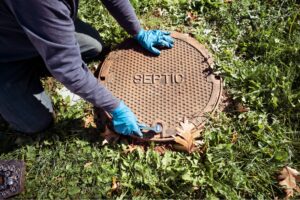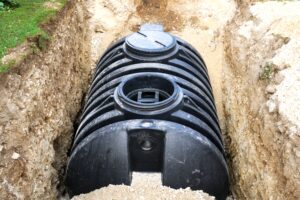by Paige Jessup, Climate Change Resiliency Intern
A septic system that is not properly installed or old and failing can have devastating consequences for freshwater ecosystems, so take time to learn how to properly install and care for your septic system. Installing or replacing your septic system can look like a daunting and expensive task so here are a few tips you can use when funding, designing, and installing your septic system.
Funding
There are many great funding options available for landowners wanting to upgrade or install a new septic system. These programs can be through local conservation authorities, private funding programs, and municipal, provincial, and federal governments. Most of these grants cover at least 50% of the project at various amounts. There are options for homeowners, farmers, and people who own land with any significant wildlife habitat. There are also some interest free loans you can apply for when taking on any major home retrofits. Spend some time researching different options in your area and for your septic needs.
Designing and Planning
When thinking about replacing or installing a new septic system, it is a good idea to contact a reputable company to come and install it. It is also important to do your own research to have a better understanding of what kind of system is best for your family’s needs and how your system will be set up. Start by choosing a spot for your system; choose an area with level ground, avoiding tree roots that could damage your tank, areas that are prone to flooding, and ensuring you have enough space for the drainage field (Crownholm, 2024). The drain field needs to have soil with good drainage so you will want to test your soil first.
There are many other types of systems available. There is the drip distribution system that requires a large amount of piping and has much less disruption of the lawn to install. Next is an aerobic treatment unit which is very efficient at managing waste and can be one of the best options available, although they tend to be more expensive to install. Mound systems are best for individuals who need an economical unit that is does not require a lot of space. A recirculating sand filter system has two septic tank areas and a built-in sand-based filter system that can last for years. This type of system does have more physical parts to install.
There are also evapotranspiration systems which are an excellent choice for the environment and will help you keep a clean and efficient septic system. A constructed wetland system is a good option for a home built on a wetland area. This system type is designed to work with the nearby water system to filter your wastewater so it is safe to be reused. Finally, you may consider a cluster/community system if you are looking for a more cost-efficient option for a large suburban area (not a single home). Work with a contractor to come up with the best set up for your property and your lifestyle.

Permits
In Ontario, septic systems are regulated by the Ministry of the Environment, Conservation and Parks (MECP) through the Ontario Water Resources Act and Environmental Protection Act, or the Building Code Act administered by the Ministry of Municipal Affairs and Housing, depending on their size and characteristics. There are three possible authorities offering a septic system program under Part 8 of the Ontario Building Code, Health Units, Conservation Authorities, Municipalities.
To find out who has jurisdiction over your property, contact your local municipality or district office. Once you find out who offers the program in your area, contact them to get an application to get a septic system or look for it on their website. When you are applying, make sure you have all the information you will need. This will include a property description, plan, lot, sub-lot, and municipal address. You will also need to complete all schedules and municipal forms, as well as a site plan of the property, including all features and locations of wells, buildings, driveway, fences, docks, garages, outbuildings, and lot dimensions. Finally, you will need to provide clear directions to the site, and a list of all neighbouring septic and well locations within 100 feet (30 metres). A contractor can help you with the application process.
Installing
Now it is time to install your septic system. The contractor you are working with will help you through the process as it can be complex and time consuming. However, it is good to know what the general process will be. Once you have a location picked out, it is time to start digging! Several trenches will be dug for the drainage pipes. These will need to be lined with gravel and sand, which will help disperse water into the soil (Crownholm, 2024). The tank will be buried several feet into the ground but this will depend on the type of system you have chosen. Finally, the entire system will be placed in the holes and buried. Now your septic system is ready to function.

Maintenance
Maintaining your septic system is important to ensure it functions properly. A failing septic system can cause untreated waste water to leach into groundwater or runoff into nearby water bodies, causing issues for terrestrial and aquatic ecosystems. There are many things you can do to take care of your septic system:
- Reduce your water use to keep solid sludge settled on the bottom of the tank.
- Have your septic system inspected and pumped every three years and keep a record of all maintenance work.
- Keep a perimeter around the edge of the drain field that is clear of trees and shrubs. How big of a perimeter depends on the plant species – be sure to do some research!
- Carefully research before using any septic additives, as some are not effective and may harm your system depending on your septic system type.
- Don’t drive or park vehicles on top of your drain field, as this can compact the soil and damage pipes.
- Don’t use cleaners, soaps, and detergents with phosphates.
- Don’t flush anything that you didn’t produce, except for toilet paper! That means no fats, grease, paints, cat litter, sanitary products, diapers, wipes, cigarette butts, or kitchen waste.
- Don’t water your lawn over the drain field.
This blog is part of a larger education toolkit about septic systems. To access all of the resources from the toolkit, visit watersheds.ca/septics
Your $5 donation today will ensure more landowners, municipalities, and families have access to the resources they need to protect Canada’s freshwater – donate now!
References
“10 Different Types Of Septic Systems + How to Choose the Right One.” (n.a.). The Original Plumber Septic. Retrieved from https://theoriginalplumber.com/plumbing-tips/types-of-septic-systems/
Crownholm, R. (2024). “A Beginner’s Guide To Septic Tank Installation.” My Site Plan. Retrieved from https://www.mysiteplan.com/blogs/news/how-to-install-a-septic-system-beginners-guide
Reid, T. (2022). “Septic Systems: they may be out of sight, but they shouldn’t be out of mind!” Watersheds Canada. Retrieved from https://watersheds.ca/septic-systems-they-may-be-out-of-sight-but-they-shouldnt-be-out-of-mind/
“Septic System Approval Process.” (n.a.). Onsite Wastewater Association. Retrieved from https://www.oowa.org/homeowner-resources/septic-system-approval-process/
